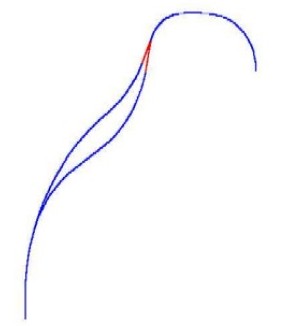- The alpha angle defines the relationship of the rim to the first cup radius. Rb tangent to R1=L1 or Alpha.
- The term "alpha" (first letter of the Greek alphabet) refers to the "first angle".
- The alpha angle has a very dramatic effect on mouthpiece performance.
- Every mouthpiece has an alpha angle. GR is the first to actually define the alpha angle mathematically.
We describe alpha angle as either high, or low. - To best way to describe alpha angle and how it impacts on your chops is to compare it to a swinging door.
- The bite radius Rb is the hinge, the lip is the door, and the Alpha Angle is the doorstop.
- The less the door opens, the higher the Alpha Angle.
The Alpha Angle is player and embouchure specific.
You must find the correct Alpha Angle for you in order to optimize your performance!

Alpha Angle is indicated in RED.High Alpha Angle to the left.
Low Alpha Angle to the right. A High Alpha Angle can support the chops.
- It can hold the chops and support them.
- It can assist in keeping the buzzing area small.
- If two mouthpieces are the exact same diameter, the one with the higher alpha angle may feel smaller.
- All of this can be good for you if you do not have much lip engagement into the cup.
- If you do, or if the alpha angle is just too high for you, you could experience lack of control, high blow resistance because the chops are being held too closed, poor articulations, intonation may suffer, thin sound, your chops could feel like they are "thinning out", and you could actually "bottom out" stopping vibrations completely.
A Low Alpha Angle will give you more chop room at the top of the cup. - The lower the Alpha Angle, the greater the lip room will be in the first cup.
- If it is too low, it may feel like you have no support or lack of compression, articulation will suffer and you may experience what we call an "air biscuit".
- An Air Biscuit occurs when your lips are pinned open, the air keeps flowing, but the vibration stops.
- If the Alpha angle is too low, intonation, endurance, attacks, flexibility, brilliance, and upper register may suffer.
Some mouthpiece manufacturers refer to alpha angle as "relief" or "undercut". This tells you nothing because it has no "physical quantity" that is defined mathematically. For instance, you know you can play on a GR Mouthpiece with an alpha angle of 15 degrees. What happens when you try one with a 17 degree alpha angle? Let's say that you bottom out on it. Now we have defined parameters and if you wish to have a smaller volume cup, we know that 15 degrees works for you, and there is no guesswork when it comes to your next mouthpiece. If you just play another mouthpiece with an "undercut", how do you know if the next piece you try with a different "undercut" or "relief" will work? This is one reason why GR Technologies has defined the Parameters of the Mouthpiece.
Hint! Standard GR Mouthpieces have alpha angles that drop as the cups get larger in volume. The alpha angle is lower on the MS cup than on the S cup. The reason for this is that players who are used to the larger volume cups, are also used to lower alpha angles. Also, this is an excellent system for finding out which alpha angle works for you. Let's say your chops can not tolerate the higher alpha angle of the S cup. You feel great on the M cup but you want less volume for your lead playing. GR can custom build you a smaller volume piece yet keep the alpha angle of the M cup to give you the feel you are after!
|